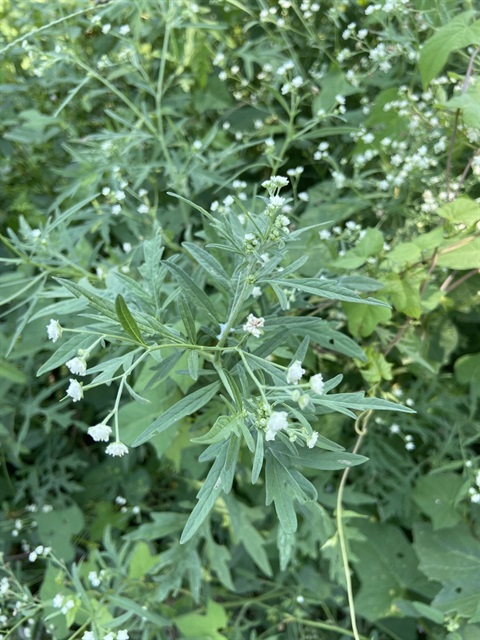Weed of the Week: Parthenium weed
Published on 25 October 2024

Welcome to week five of Weed of the Week for the 2024/25 spring and summer season. Through this series of articles, Council provides the Snowy Monaro community with information and advice on the new, emerging and established invasive plant species threatening our region.
Whether you’re living on the land, living in town, or just passing through – we all have a part to play in protecting our natural environment and agricultural land from invasive plants and weeds.
This week we’re focusing on parthenium weed (Parthenium hysterophorus). Parthenium weed originates in parts of North and South America, and is a fast-growing, annual herb with distinctive, small white flowers. Parthenium weed can germinate, grow and set seed within four weeks, enabling it to germinate multiple times in a season and allowing rapid spread. It can cause significant allergic reactions, dermatitis, hay fever and asthma in humans and is a serious agricultural weed.
Parthenium weed is a serious pasture invader in Queensland, where it currently infests over eight million hectares. While sporadic incursions into NSW occur from plant, machinery and fodder movements, it has not become established within this state and significant resources are invested into maintaining this status quo.
The NSW Biosecurity Act 2015 imposes strict border restrictions on the movement of machinery, and in particular harvesting equipment from Queensland. It imposes harsh penalties on those who do not report the incidence of this weed or take necessary action to eliminate it from their land.
Parthenium weed is a Weed of National Significance and classified as prohibited matter in NSW. If you see this plant, you must report it to either Council on 1300 345 345 or the NSW DPI Biosecurity Helpline on 1800 680 244. Due to the seriousness of this weed, if it’s detected on your land you will be provided with the necessary resources to eliminate it.
Why parthenium weed is a problem:
Parthenium weed is regarded as one of the worst weeds in Australia.
All parts of the parthenium weed plant, at any stage of growth, are toxic to humans and animals. It can cause respiratory problems and severe dermatitis. People might not have an allergic reaction the first time they touch the plant, but allergies can develop after a few exposures. Once a reaction to parthenium weed develops, some people go on to develop allergies to related plants such as sunflowers.
Livestock do not usually eat parthenium weed, but if no other feed is available they may eat large amounts. This can cause kidney damage in ruminants (cattle, sheep and goats), with young cattle most susceptible to dying from parthenium weed poisoning. Animals may also have allergic reactions including dermatitis. If livestock – especially sheep – eat parthenium weed within one month of slaughter, it can taint the flavour of their meat.
Parthenium weed produces allelopathic substances that deter other plants from germinating and growing near it. This enables the weed to dominate pastures and reduce carrying capacity and crop yields by as much as 90%.
What do you have to do if you detect parthenium weed?
Do not attempt to destroy or control parthenium weed on your own. If you find, or suspect you have found, parthenium weed on your property, in public, or anywhere else in our region – you must call Council on 1300 345 345 or the NSW Biosecurity Helpline on 1800 680 244 immediately.
This weed poses such a significant risk to our region that it is critical that it is dealt with quickly and professionally.
Council will provide prompt and thorough weed identification and control at no cost to the landowner where parthenium weed is suspected or confirmed.
What can you do?
• Learn to identify parthenium weed and take specific precautions if introducing fodder, livestock or machinery from Queensland’s rangelands and cropping areas
• Be on the lookout for the distinctive flowers of parthenium weed over the summer period and seek immediate advice if you identify any suspect plants
◦ Flowers grow on the stem tips and are small, white and 4mm across with five distinct corners
Council is here to help. If you have questions about parthenium weed, or any other weeds – contact our specialist biosecurity officers for advice and assistance.
Call 1300 345 345 or email council@snowymonaro.nsw.gov.au
Can’t identify a weed? Send in some photographs or arrange a free onsite inspection and one of our staff will promptly respond.
Download the free NSW WeedWise app for detailed information on how to identify and manage weeds. Visit www.dpi.nsw.gov.au/biosecurity/weeds
Visit the Department of Primary Industries (DPI) website for information on weed control methods – www.dpi.nsw.gov.au/biosecurity/weeds/weed-control
For more information about weeds and biosecurity in the Snowy Monaro, visit our website at https://qrco.de/SMRCweeds